You will need
- cloth;
- - tailoring meter or centimeter tape;
- - threads;
- - scissors;
- pencil for marking;
- - needle;
- - pins;
- - a sewing machine.
Instruction
1
Select the model of curtains that you think is most suitable for your interior. They can consist of one, two or more webs of fabric, as they can decorate ribbons or ruffles. There are also curtains with pelmet - a special strip of cloth hanging from above, at the eaves in front of the main canvas. From the model will depend on the type and amount of fabric you will need to purchase.
2
Measure the window's width and the height of the room from the ledge to the desired length of curtains. On the basis of these indicators, you will be able to calculate the necessary amount of tissue. The future width of the curtains will depend on how lush folds you want to do. A possible factor in the calculations range from 1.3 to 3. With the figure of 1.3 your curtains in the unfolded state are almost straight, and with 3 they will keep large waves. To calculate the amount of fabric you will need to multiply the window width or the length of the cornice for the selected coefficient. For curtains may also vary. if you want to make curtains with a slouchy fit, it is necessary to increase their length relative to the desired indicator. In the same way, calculate how much fabric you will need for making ruffles or lambrequin.
3
Buy fabric for curtains. This can be done in a specialty store, designed for lovers of sewing. Focus not only on the appearance of the fabric, but also on its ability to transmit light. For this reason you will be able to advise the seller in shop.
4
Cutting curtains made from purchased fabric. The easiest way to do it directly on the fabric without using a paper pattern. This is possible because the curtain is a simple rectangle or square. Don't forget to take into account the seam at least two inches, and also keep in mind when cutting the space for the loops which the curtain will be attached to the eaves.
5
Hem the cut elements curtains. For this it is best to use the seam "goat" closed edge. In this case, the seams will not be visible from the outside of the fabric. Modern sewing machines have special modes to play such seams.
